Hey there, fellow aquarists! Have you ever wondered about the secret to a thriving aquarium? In all my years of fish and shrimp keeping, I’ve found that it’s not just about the fancy equipment or the exotic species you own. One of the most critical factors in maintaining a healthy aquarium, believe it or not, is the pH level of your tank water.
From my first betta fish in a simple bowl to the now bustling community of vibrant guppies and neocaridina shrimps in my 50-gallon tank, it’s been quite a journey. I’ve learned a lot along the way, but I recall a time when my lack of understanding about the importance of pH nearly led to a disaster.
I had just introduced some new Crystal shrimp into my established tank, not realizing that they prefer slightly acidic water. My tank, on the other hand, had a pH level leaning towards the alkaline side. Needless to say, my new additions were not happy, and their stress levels were high. That’s when I learned about the crucial role pH plays in the well-being of our aquatic friends.
From that day on, I’ve made it my mission to maintain the optimal pH balance for my fish and shrimp. It’s not always an easy task, but with a few natural methods and a little patience, it’s certainly achievable. And the reward? A thriving, colorful, and lively aquarium that’s a joy to watch and maintain.
So, if you’re like me a few years ago, wondering why your fish or shrimp aren’t as active or healthy as they should be, you might want to check your pH levels. Stick around, and I’ll walk you through my tried and tested methods of lowering pH naturally in an aquarium.
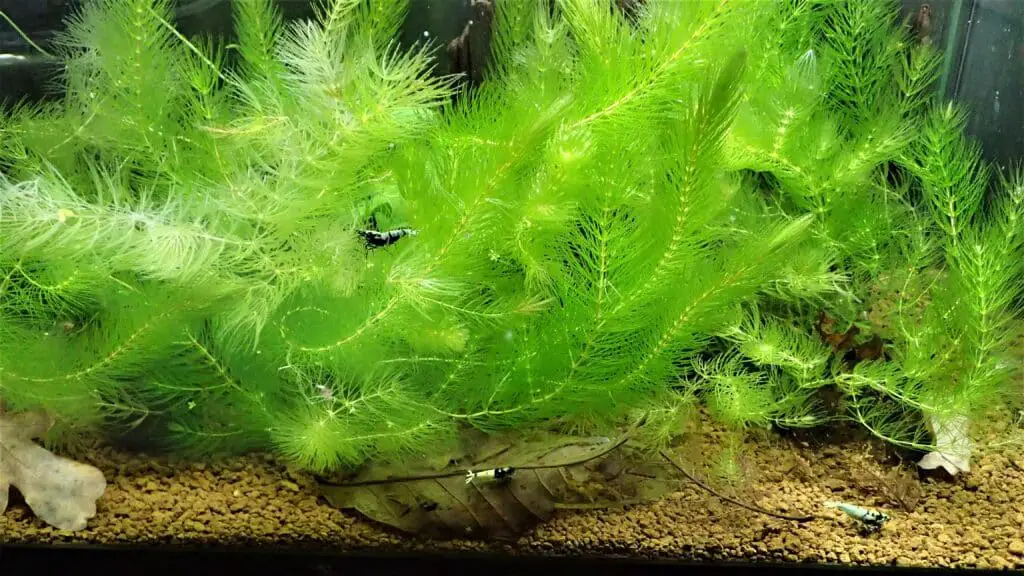
From Source Water to Aquarium: A Guide to Lowering pH Levels
Before we dive into the nitty-gritty of adjusting pH levels, let’s take a moment to understand what pH is and why it matters so much to your aquatic inhabitants.
pH is a measure of how acidic or basic the water in your aquarium is. The pH scale ranges from 0 to 14. A pH level of 7 is considered neutral. Anything below 7 is acidic, and anything above 7 is alkaline or basic. Now, you might be thinking, “That’s great, but why does my fish or shrimp care about this?”
Different species of fish and shrimp come from a myriad of unique habitats worldwide, each with its own distinct source water chemistry. Some species originate from areas with soft, acidic source water, such as the Amazon basin’s blackwater streams. In contrast, others hail from environments with hard, alkaline source water, like the African Rift Lakes. The pH range that these species can comfortably and healthily live in is determined by the characteristics of their native source water.
For instance, neon tetras and crystal red shrimps prefer slightly acidic conditions, with a pH of around 6.0 to 6.5. On the other hand, African cichlids thrive in more alkaline water, with pH levels between 7.5 and 8.5.
prefer slightly acidic conditions, with a pH of around 6.0 to 6.5. On the other hand, African cichlids thrive in more alkaline water, with pH levels between 7.5 and 8.5.
When fish or shrimp are kept in water with a pH level outside their preferred range, they may become stressed, less active, and more susceptible to diseases. In extreme cases, incorrect pH levels can even be fatal.
That’s why it’s crucial to understand the preferred pH range of each species in your aquarium and aim to maintain it. It’s not just about keeping your tank’s inhabitants alive but about providing them an environment where they can thrive and exhibit natural behaviors.
So, next time you plan on adding a new member to your aquarium community, don’t just consider if they’re a good match in terms of temperament and size. Remember to check if your tank’s pH levels align with their needs too!
How To Lower Ph In an Aquarium Naturally
Now that we’ve established the significance of maintaining the right pH levels let’s discuss how we can lower it naturally when needed. Why naturally, you may ask? Well, while there are chemical products available that can quickly adjust pH levels, I’ve found that they often lead to sudden changes that can stress our aquatic friends. In contrast, natural methods bring about more gradual changes, closely mirroring the slow-changing conditions in their wild habitats.
In this article, I’m going to share with you the top five natural methods I’ve successfully used to lower pH in my aquariums. These include:
- Aquarium Soil: A unique substrate that can help reduce pH levels while also providing essential nutrients for plants
 .
. - Reverse Osmosis
 (RO) Water: Though this method requires some equipment, it can be very effective, especially if you’re dealing with hard water.
(RO) Water: Though this method requires some equipment, it can be very effective, especially if you’re dealing with hard water. - Active Soil and RO Water with a Suitable Buffer: A combination method for more precise control over your pH levels.
- Driftwood: A natural and visually appealing method that can also provide hiding spots for your tank inhabitants.
- Leaf Litter like Alder Cones and Dried Leaves: Another natural approach that mimics many natural aquatic environments.
Remember, each tank is unique, and what works for one may not work for another. Feel free to experiment with these methods and find out what works best for your specific situation. The key is to make changes gradually and always monitor the pH levels to ensure they stay within the preferred range for your fish or shrimp.
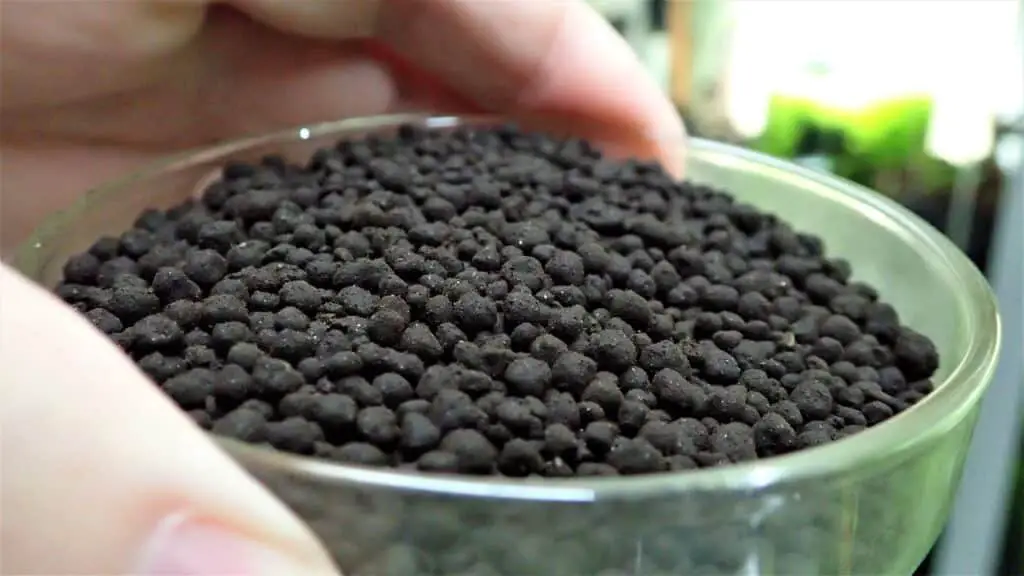
1. Using Aquarium Soil to Adjust pH
Let’s kick things off with one of the simplest and most effective methods of lowering your aquarium’s pH: using aquarium soil. Now, I don’t mean that you should go outside and scoop up a handful of dirt from your garden – aquarium soil is a special kind of substrate designed specifically for use in aquariums.
Aquarium soil is not only a great base for your plants, but it also has the handy property of naturally lowering the pH in your tank . This soil is often made from decomposed plant material, volcanic ash, or other natural substances that release tannins and other organic compounds into the water. These compounds naturally soften the water and reduce the pH.
. This soil is often made from decomposed plant material, volcanic ash, or other natural substances that release tannins and other organic compounds into the water. These compounds naturally soften the water and reduce the pH.
I’ve had fantastic results using aquarium soil in my tanks. Not only has it helped maintain a slightly acidic pH ideal for my shrimps, but it’s also provided essential nutrients for my plants. The vibrant green leaves and healthy growth are a testament to the benefits of this substrate.
There are many different brands of aquarium soil available, but my personal favorite is ADA Amazonia soil. It’s specifically designed to lower pH and soften water, making it perfect for fish and shrimp that prefer these conditions.
It’s also important to note that the impact on pH can vary depending on the specific brand and type of soil you use, so monitor your pH levels regularly to ensure they’re within the desired range.
And a word of caution: the soil may cause an initial spike in ammonia levels, so it’s best to let your tank cycle and stabilize before adding any fish or shrimp. Trust me, a little patience at the start will pay off with a thriving, balanced aquarium in the long run!
levels, so it’s best to let your tank cycle and stabilize before adding any fish or shrimp. Trust me, a little patience at the start will pay off with a thriving, balanced aquarium in the long run!
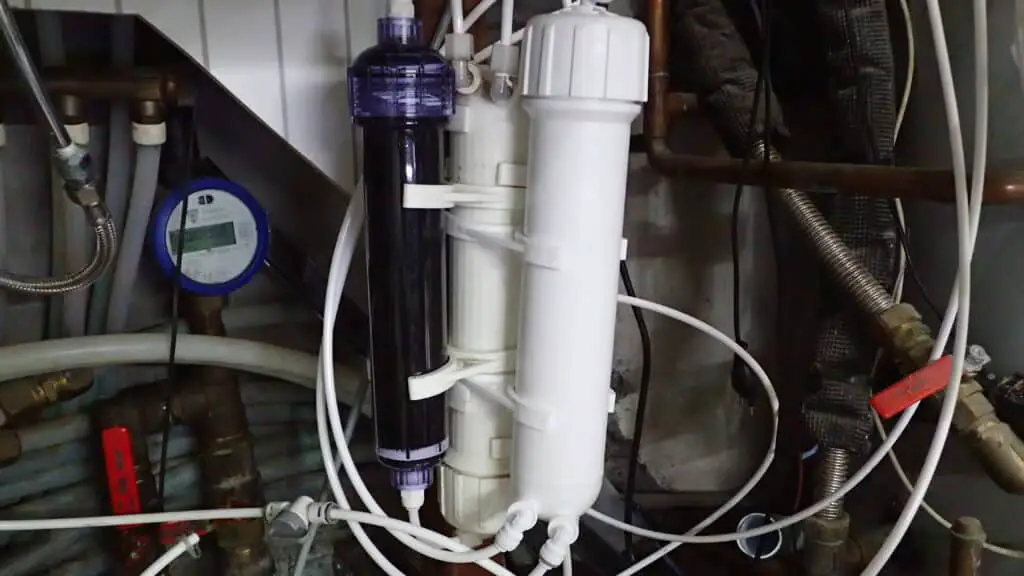
2. Utilizing Reverse Osmosis (RO) Water In Aquariums
Reverse osmosis water, commonly known as RO water, is a reliable and efficient way to adjust and maintain the pH in your aquarium. But before we dive into its benefits, let’s first understand what RO water is.
RO water is produced by a process called reverse osmosis, where water is forced through a semipermeable membrane to filter out impurities, resulting in extremely pure water. This purified water is typically neutral, meaning it has a pH of about 7.0. So, if your aquarium’s water is particularly hard or alkaline (pH over 7), using RO water can help bring it down to a more neutral level.
Now, onto my personal experience with RO water. I’ve been using it in my aquariums for several years now, and I’ve found it to be an excellent tool for maintaining stable water conditions. It’s particularly useful if you’re living in an area with hard tap water that tends to push your aquarium’s pH too high.
One thing to note is that while RO water is great for adjusting pH, it’s also devoid of minerals that are essential for the health of your fish and shrimp. Therefore, I always make sure to remineralize my RO water with a commercial re-mineralizer, ensuring my aquatic friends get the necessary minerals they need for growth and overall health.
In addition to RO water, distilled water and rainwater can also be used to lower the pH in your aquarium. Like RO water, both are typically neutral and can bring down the pH if you’re dealing with hard water. However, both need to be treated appropriately before use.
Distilled water undergoes a process of distillation, which removes all minerals and impurities. Although it’s pure, it lacks the necessary minerals, so just like with RO water, you’ll need to add those back in.
Rainwater, while a natural source, can contain pollutants and contaminants, especially in urban areas. If you’re considering using rainwater, make sure to filter and treat it properly to ensure it’s safe for your aquarium.
3. Active Soil and RO Water with a Suitable Buffer: A Combination Method for More Precise Control Over Your pH Levels
Sometimes, a singular method might not give you the precision you need when it comes to controlling pH levels in your aquarium. That’s where a combination of active soil and RO water, along with a suitable buffer, comes into play.
Let’s first break down what each component does.
Active soil, also known as buffering substrate, is a type of aquarium soil that is designed to reduce the pH of your water naturally . It does this by releasing tannins and other organic acids into the water, which works to lower the pH over time.
. It does this by releasing tannins and other organic acids into the water, which works to lower the pH over time.
The trick with active soil is to monitor the pH levels closely, especially in the beginning. It’s a powerful tool, but it can lower your pH more than you might expect. I’ve learned this the hard way, so be sure to test your water parameters regularly when using active soil.
Next is RO water, which we discussed in detail in the previous section. RO water, with its neutral pH, helps bring down the pH in your aquarium if you have hard water.
Finally, we have buffers. Buffers are substances that resist changes in pH. When used in an aquarium, a suitable buffer can help stabilize your pH level, preventing sudden spikes or drops that could harm your fish or shrimp.
In my experience, the combination of active soil, RO water, and a suitable buffer has been a game changer. The active soil works to lower the pH, while the RO water helps to start with a neutral base. The buffer then ensures that the pH stays stable, resisting any drastic changes.
This combination method gives me more precise control over the pH levels in my aquariums. It’s like having a fine-tuned control dial for your water parameters. However, keep in mind that it requires regular testing and tweaking to get the balance just right. It’s a bit more work, but for me, the health and happiness of my aquatic friends make it all worthwhile.
Remember, every aquarium is different, and what works best for one might not be the best for another. So, experiment with this combination method, monitor the results, and see if it’s the right fit for your aquarium.
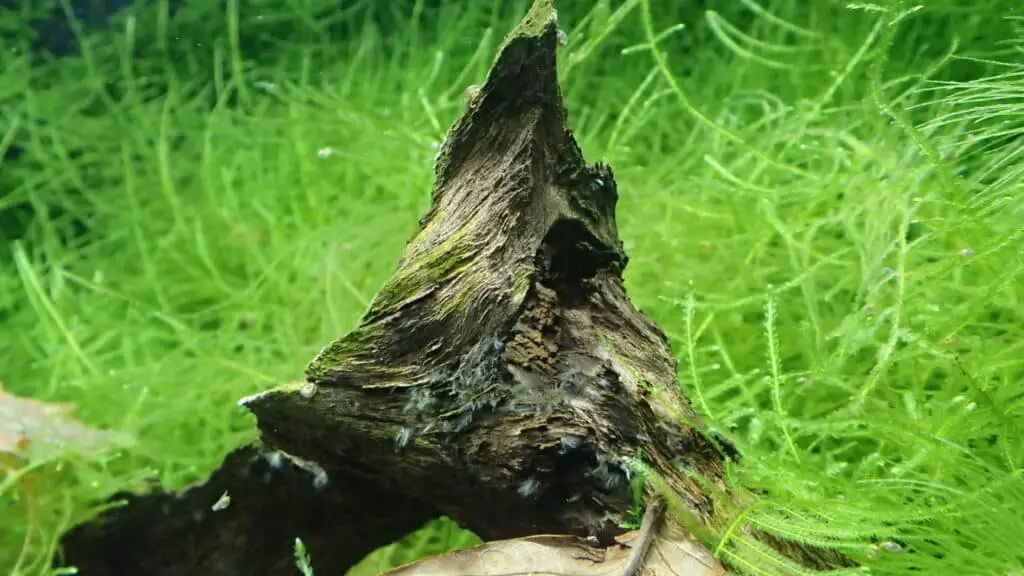
4. Incorporating Driftwood
Driftwood, apart from being a visually appealing addition to your aquarium, is a natural and effective way to lower the pH of your water. It releases tannins over time, which are natural compounds that acidify the water and lower its pH. It’s almost like brewing a cup of tea, where the driftwood plays the role of the tea bag, steeping the water in a soft, acidic brew.
I’ve been using driftwood in my aquariums for years, not just for its pH-lowering properties, but also because it provides an excellent natural environment for the tank inhabitants. Fish love to hide around it, and some species even use it as a spawning site. Plus, it can also serve as a food source for some algae eaters and shrimps.
When it comes to choosing driftwood, make sure you select types that are safe for aquarium use. Malaysian driftwood, Mopani wood, and Manzanita wood are all excellent choices, each with unique shapes and colorations. It’s important to remember that not all wood is safe for your tank, so always source your driftwood from a reliable supplier.
use. Malaysian driftwood, Mopani wood, and Manzanita wood are all excellent choices, each with unique shapes and colorations. It’s important to remember that not all wood is safe for your tank, so always source your driftwood from a reliable supplier.
Before adding driftwood to your tank, it’s crucial to prep it properly. Boil the wood in water for a couple of hours to sterilize it and to help release any trapped tannins. This process also helps to waterlog the wood so it will sink in your aquarium. Even after boiling, the driftwood will still release tannins gradually, so don’t worry about losing the pH-lowering effect.
gradually, so don’t worry about losing the pH-lowering effect.
Once in your tank, the driftwood may cause the water to take on a slightly brownish hue due to the tannins, giving it a natural, blackwater look. If this isn’t to your liking, activated carbon in your filter can help remove the tannins and clear the water.
in your filter can help remove the tannins and clear the water.
Remember, the effect of driftwood on your aquarium’s pH will depend on its size and the type of wood. Keep an eye on your pH levels and adjust as necessary. So, if you’re looking for a way to lower your pH and add a stunning natural element to your tank, driftwood is a fantastic choice.
Top Tip On Drift Wood
If you buy it second hand make sure you boil it before adding to your tank like I mentioned above, not doing so allows parasites like planaria and hydra to enter your tank.
to enter your tank.
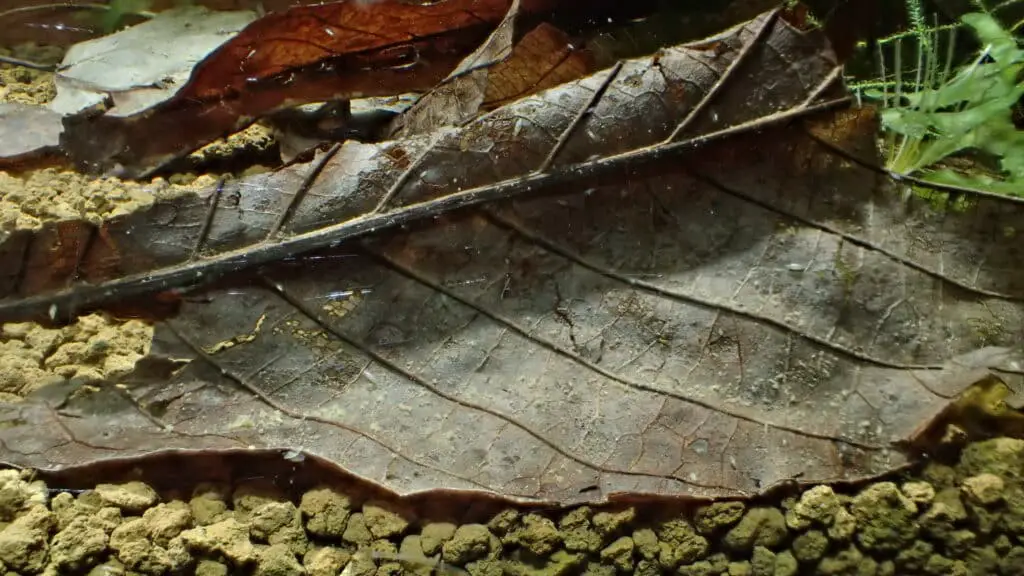
5. Using Leaf Litter like Alder Cones and Dried Leaves To Lower Ph
Leaf litter, which includes items like alder cones and dried leaves, is a lesser-known but highly effective method for naturally lowering pH in an aquarium. Just like driftwood, leaf litter releases beneficial tannins into the water, which in turn decrease the pH.
I first stumbled upon this method during my early years in the hobby, and I must say, it’s become one of my favorites. Not only does leaf litter help create a more natural-looking environment, but it also provides additional hiding spots for my fish and shrimp.
Alder cones have a minor impact on pH levels. Despite being effective at softening water, they have little influence on lowering pH levels. Their small size may make them unobtrusive, but they do not pack a significant pH-lowering punch like soils do.
Dried leaves, such as Indian almond leaves or oak leaves, work in much the same way. As they decay in the water, they release tannins, helping to acidify the water and lower the pH. Plus, both fish and shrimp love to nibble on the biofilm that forms on the decaying leaves, so they serve a dual purpose.
Before adding any leaf litter to your tank , it’s essential to prepare it properly. I usually boil alder cones and leaves for a few minutes to sterilize them and rinse off any dirt or debris. Just be aware that, like driftwood, leaf litter may tint your water a tea-like color. If you’re not a fan of this look, activated carbon can help clear it up.
, it’s essential to prepare it properly. I usually boil alder cones and leaves for a few minutes to sterilize them and rinse off any dirt or debris. Just be aware that, like driftwood, leaf litter may tint your water a tea-like color. If you’re not a fan of this look, activated carbon can help clear it up.
Finally, remember to replace your leaf litter periodically as it breaks down. Keeping a close eye on your pH levels will help you determine the right replacement schedule. Trust me, once you start using leaf litter, you’ll love the natural look and benefits it brings to your aquarium!
Tank Safety Precautions
When it comes to adjusting the pH of your aquarium, one thing I cannot stress enough is the importance of making changes gradually. Aquatic creatures are highly sensitive to changes in their environment, and a sudden shift in pH can be extremely stressful – and even fatal.
In my years of experience, I’ve seen the damage that rapid changes can cause, and it’s not a pretty sight. Fish can become lethargic, lose their appetite, or even worse, go into shock. Shrimp, being even more sensitive, can suffer severe stress leading to high mortality rates.
Remember, your goal is to create a stable, healthy environment for your aquatic friends. This isn’t a race, so take your time and make adjustments little by little. I generally recommend changing the pH no more than 0.2 units per day. Even if your pH is far off from your target, resist the urge to rush things. Patience is key here.
Testing your water frequently is also crucial. You’ll want to keep a close eye on the pH as you make adjustments to ensure you’re moving in the right direction and not inadvertently causing a major shift. I usually test the water every day when making adjustments, and once a week when things are stable.
Finally, an important note to remember is that ideally, you should get your water parameters, including pH, right before introducing your fish or shrimp into the tank. Introducing them to a tank where the pH is still fluctuating can be very stressful for them. It’s better to wait a little longer and ensure their new home is perfectly ready for them.
Adjusting the pH in your aquarium may seem daunting, but with a bit of knowledge, patience, and care, you can create the perfect environment for your aquatic pets to thrive. Trust me, the rewards of seeing them happy and healthy are well worth the effort!
Aquarium Maintenance: Keeping Things Clean and pH-Stable
Now, let’s talk about one aspect of aquarium keeping that’s incredibly important, yet often overlooked – aquarium maintenance. Regular maintenance is critical to keep your tanks clean and, more importantly, to avoid unwanted and harmful changes in your water parameters, including pH.
You might wonder – how does a dirty tank affect my pH levels? Well, when organic waste starts to accumulate, it begins to decay. This decay process produces acidic by-products which can cause your pH to drop.
Sounds like a good thing, right? After all, we’re trying to lower our pH! Well, not quite.
While this might seem like a nifty way to lower your pH, it’s actually quite harmful. The decay process also produces harmful substances like ammonia, nitrite, and nitrate. These can be toxic to your fish and shrimp, leading to poor health or even death.
Plus, this kind of pH decrease is unpredictable and difficult to control. One day, your pH might be just right. The next, it could plummet. These sudden changes in pH are very stressful for your aquarium inhabitants and can lead to a lot of problems.
So, what can we do? The key is regular maintenance. Here’s what I recommend:
- Regular Water Changes: Change out a portion of your water regularly. This helps dilute any harmful substances and keeps your pH stable.
- Cleaning: Regularly clean your tank and filter, but be careful not to overdo it. You want to remove excess waste, but you don’t want to remove all the beneficial bacteria that help keep your water clean and safe.
- Feeding: Don’t overfeed your fish and shrimp. Excess food will just decay and cause problems.
- Observation: Keep an eye on your tank. If it’s starting to look a bit dirty, it’s probably time for a clean. If your fish or shrimp are behaving unusually, test your water parameters. They might be trying to tell you something’s off.
Remember, our goal is to create a safe, stable environment for our aquatic friends. Regular maintenance is a key part of that. It’s a bit of work, sure, but it’s absolutely worth it. Not only will your fish and shrimp thank you, but your tank will also look much nicer too!
Conclusion
So, we’ve been through quite the journey together, haven’t we? From understanding the nuances of pH in our aquariums to exploring natural ways of controlling it, we’ve covered a lot of ground.
We’ve delved into the world of aquarium soils, looked at how the neutrality of RO water can help, and even discussed a combination approach using active soil, RO water, and a suitable buffer. We’ve also explored the benefits of incorporating driftwood and leaf litter like alder cones and dried leaves into our setups.
Each of these methods has its place and can be highly effective when used correctly. But remember, our priority should always be the health and well-being of our fish and shrimp. That’s why we haven’t discussed methods like adding vinegar or using CO2. While they can affect pH levels, getting them wrong can have disastrous consequences, potentially wiping out entire tanks.
Remember that maintaining a healthy pH balance in your aquarium isn’t a one-and-done affair. It requires regular testing, observation, and sometimes, a bit of tweaking. It’s all part of the journey of being an aquarium hobbyist, and in my experience, it’s one of the most rewarding parts.
Finally, while this guide offers a wealth of information, it’s important to remember that each aquarium is a unique ecosystem. What works best for one might not be the best for another. So, feel free to experiment, learn, and most importantly, enjoy the process.
I hope this guide has been helpful to you in your journey. I’d love to hear about your experiences and any tips you might have, so don’t hesitate to share. After all, we’re all in this wonderful hobby together. Happy fish and shrimp keeping!
Frequently Asked Questions (FAQ)
1. Why is it important to lower the pH in my aquarium?
Lowering the pH in your aquarium may be necessary if the water conditions are too alkaline for the species you keep. Most freshwater fish and shrimp thrive in slightly acidic to neutral conditions. Maintaining the correct pH helps ensure their health and wellbeing.
2. How can I lower the pH in my aquarium naturally?
There are several natural ways to lower pH in your aquarium, such as using aquarium soil, incorporating driftwood, adding leaf litter like alder cones and dried leaves, and using reverse osmosis water combined with a suitable buffer.
3. Can I use vinegar or baking soda to adjust the pH in my aquarium?
While vinegar and baking soda can adjust the pH in an aquarium, it is not recommended as a long-term solution. These substances can cause sudden pH swings that are stressful for your fish or shrimp. Instead, opt for more stable, natural methods like those mentioned above.
4. How often should I check the pH in my aquarium?
Regular testing is key to maintaining a stable pH. When making adjustments, you should test the water every day. Once your pH is stable, testing once a week is usually sufficient.
5. What pH level is suitable for my fish or shrimp?
The ideal pH level depends on the species you keep. Most freshwater fish and shrimp prefer slightly acidic to neutral conditions (pH 6.0-7.0), but some species may require different conditions. Always research the specific needs of your species before making adjustments.
6. Can I add fish or shrimp to my aquarium while I’m adjusting the pH?
Ideally, you should stabilize your water parameters, including pH, before introducing fish or shrimp into the tank. Sudden changes in pH can be stressful or even fatal to aquatic creatures. It’s better to wait until conditions are stable before adding your pets.
